2-4 Shirane Shirakata, Tokai-mura, Naka-gun, Ibaraki 319-1195, Japan
Webmaster:<web-staff@j-parc.jp>
J-PARC Neutrino Facility: Source of the World's-highest Intense Neutrino Beam

The proton beams emitted by the Main Ring synchrotron are directed westward through the primary beam line, where many normal-conducting / super-conducting magnets and beam monitors are placed along the trajectory. At the target station the protons collide with a target composed of graphite rods and produce numerous daughter particles. Among these particles, the positively charged π-mesons –the parents of muon neutrinos– converge in the forward direction under the effect of magnetic horns. Magnetic horns are magnets designed to focus charged π-mesons by applying a few hundred thousand amperes of pulsed current synchronized with each beam shot. The π-mesons then decay into pairs, each comprising a muon and muon neutrino, during the flight in a 100-m-long tunnel (decay volume). All the neutrinos (and a small fraction of muons) escape from the facility, whereas all the other particles such as the remaining protons and undecayed π-mesons are absorbed by a beam dump composed of large graphite blocks. The profile of the muons that penetrate the beam dump is used as an indirect monitor of the neutrino beam direction. Neutrino detectors located 280 m downstream of the target can measure the profile, purity, and energy distribution of the muon neutrinos. A comparison of the measurements with those observed at the Super-Kamiokande will facilitate detailed studies of neutrino oscillation. |
∗@ A unique feature of the J-PARC neutrino experimental facility is that, this is the first application of the off-axis beam configuration, where the centre of the neutrino beam direction underground is shifted by a few degrees with respect to Super-Kamiokande. By adjusting the off-axis angle, we can tune the peak of the semi-monochromatic beam to the expected oscillation maximum. The center of the neutrino beam passes Sea of Japan.
Primary Beam-Line
The primary beam-line consists of three sections: A preparation section to tune beam extracted from MR, an arc section to bend beam towards Kamioka, and a final focusing section to focus beam onto the target. Normal-conducting magnets are used for the preparation section and final focusing section.
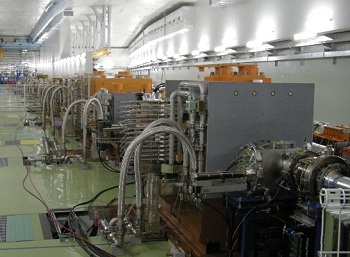
Preparation section (up): Final focusing section (right) |
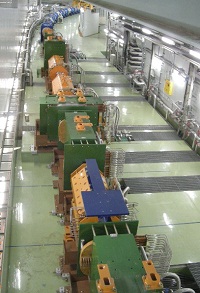
|
In the arc section with radius of 104m and the length of about 150m, the beam is bent about 80 degree by 28 Super-conducting Combined Function Magnets (SCFM). This is the first attempt to develop a combined function magnet as a superconducting device. It is 3.3m long, where dipole and quadrupole components are 2.6T and 18.6T/m, respectively. Two SCFM magnets are assembled inside one cryostat (doublet).
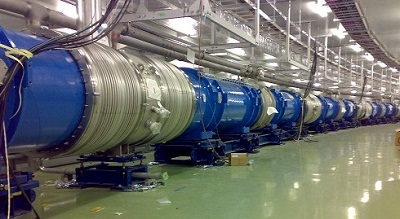
|

SCFM: Super-conducting Combined Function Magnets (left) Magnetic field distribution (up) |
Intensity (current transformer), position (electro-static monitor), profile (segmented secondary emission monitor), and beam-loss monitors are installed along the beam-line
Target Station, Target and Horn System
The target station is a building with a remote-handling crane, to maintain the highly-irradiated horns and target from a distance. The main component is a large vacuum vessel made with a volume of 1,500m3, where a production target, magnetic horn system, optical beam profile monitor (OTR), and related apparatus are installed and kept under a helium atmosphere. The helium vessel is enclosed in thousands tons of iron cast blocks and concrete shield blocks for radiation protection.
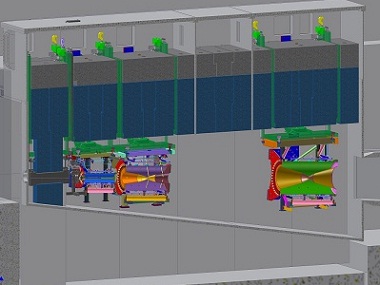
Cross section of the TS helium vessel (up): Installation of the magnetic horn-2 (left) |
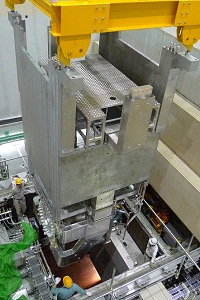
|
Three magnetic horns are operated to focus generated pions in the forward direction. They are composed of inner and outer conductors and large bus-bars made of aluminium. By applying a 320kA pulsed current synchronized to the spill timing, a toroidal magnetic field of 2 Tesla is generated between the inner and outer conductors. The pion-production target is enclosed in the inner conductor of the horn-1. It is an isotropic graphite rod of 90cm long, enclosed in two layers of sleeves made of graphite and thin titanium alloy, respectively. The heat load on the target is removed by helium gas flowing between the sleeves. During the beam operation, the central temperature will be more than 700°C.
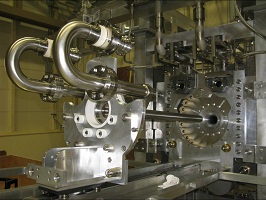
Target (up): Magnetic horn-1 (right) |

|
Decay Volume and Beam Dump
The decay volume is made of iron plates, supported in the 6m-thick concrete wall. The inside is covered with 40 channels of serially-connected plate coils. The beam dump is located at the downstream of the decay volume, where a hadron absorber, the core of the beam dump, is installed together with water-cooled iron shields. It is composed of 14 core modules. A core module is composed of large extruded graphite blocks, fastened to an aluminium cast plate with cooling water paths in it. The beam dump absorbs remaining protons and un-decayed pions, and shuts off the generated heats and radiations.

Upstream view of decay volume (up): Installation of hadron absorber, the core of beam dump (right) |
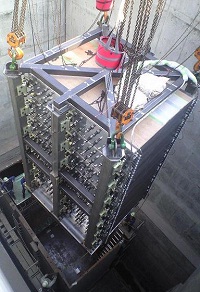
|
A muon monitor system is placed in a pit downstream of the beam dump. Since muons are produced together with neutrinos, profile centre of the muons can indirectly show that of the neutrinos.
Near Neutrino Detectors
An experimental hall for neutrino monitor is located 280m downstream from the target. It has a cylindrical shape, with inner diameter 17.5m and depth 33.5m. Two independent detector systems were installed. One is placed on the beam axis (INGRID), and the other is placed on the off-axis, at the direction of Super-Kamiokande. The purpose of INGRID is to monitor direction and intensity of the neutrino beam. The purpose of the off-axis detector is to measure the spectrum of the neutrino at production. It also aims to measure contamination of the intrinsic electron neutrinos and to study electron-like background events caused by the inelastic interactions.
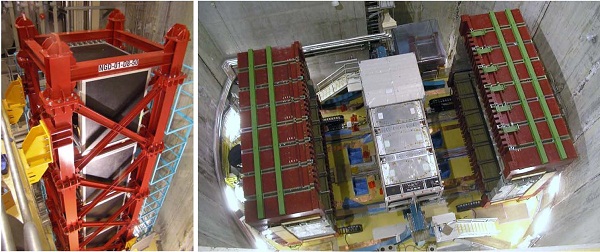
INGRID (left):@Off-axis detector (right) |
The off-axis detector system consists of multiple detector components. They are all enclosed in a large magnet, donated for T2K experiment by Europian Organization for Nuclear Research (CERN). It was originally produced for proton-antiproton colliding experiment (UA1). The experiment accomplished the discovery of the W and Z bosons (1983).



